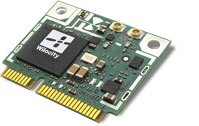High speed 60GHz wireless connectivity finally takes off

Over the last couple of years, 60GHz wireless technology has opened up a range of applications. While the technology itself has been around for years, new standards and new devices are allowing equipment for cable replacement and high speed wireless backhaul to be built.
Fig. 1 – The new IEE802.11ad 60GHz WiFi standard will allow high speed, short range links up to 7Gbit/s to connect PCs and smartphones to large screens
The 60GHz technology used for the latest IEEE802.11ad gigabit wireless systems provides very high speeds but at short distances as the signal is easily absorbed by water and other materials. This means the technology is more suited to short, high speed point to point connections, and the first major target is replacing the HDMI cable that carries high definition and 3D TV signals from the set top box to a large screen TV. It is the opportunity to put this technology into a smartphone and other portable devices that drives the current interest in the market – being able to transfer HD video to a TV screen for display is seen as a compelling application.
All this is leading to predictions by ABI Research of a market of over 1bn units a year by 2017.
802.11ad was agreed in January 2013 and at the same time the two major industry alliances – the Gigabit WiFi Alliance and the WiFi Alliance – have come together to jointly develop and promote the technology. Device makers are planning certification by the end of the year, with volume roll out already taking place in ultrabooks and peripherals for media streaming. Over 300 individuals from equipment and silicon suppliers, service providers and systems integrators from more than 20 countries participated in the ratification of the standard in December 2012, completing the process in half the time of other WiFi standards.
The fact that there is 60GHz spectrum available around the world is a key enabler, although there are slight variations in different countries (Fig. 2). This is driving a more flexible architecture in devices.
The standard divides the unlicensed 60GHz band into four 2.16-GHz wide channels. Data rates of up to 7Gbits/s are possible using OFDM with different modulation schemes. A single-channel version for low-power operation is available and can deliver a speed up to 4.6Gbits/s.
The next step is the smartphone. 802.11ad is widely seen as the next step for WiFi, after 11ac. Its use as a smartphone technology will be driven largely by media streaming and data transfer between devices, for example streaming HD video between a smartphone and a flat screen TV. WiGig / 11ad use in smartphones will determine its wider acceptance in all other markets, helping to drive adoption in connected home equipment such as TVs initially with external dongles and then becoming integrated in to the TV and set top box, Blu Ray player or next generation games console such as Xbox 720 or Playstation 4.
A version of 802.11ad developed by the WiGig Alliance also specifies an adaptive beamforming option that provides high antenna gain and a directional beam. This minimizes interference and provides the ability to adjust to the surrounding to optimize data rate and link reliability. The WiGig variant also uses protocol adaption layers (PALs) for developers to interface to specific displays like HDMI and DisplayPort as well as interfaces such as PCI Express and USB.
Israeli company Wilocity is working closely with WiFi chip developer Qualcomm Atheros and in January 2013 launched the first tri-band reference design that combined 802.11ac and 802.11ad wireless capabilities on a single module. The company started in 2007 with engineers from Intel’s Centrino group and is using Qualcomm’s VIVE 802.11ac WiFi chip alongside its own 802.11ad WiGig wireless technologies, the reference design delivers tri-band WiFi, which allows consumers to connect to 60GHz-enabled devices, docks, displays and storage at multi-gigabit speeds, while maintaining enterprise-wide or whole home coverage with 2.4GHz/5GHz WiFi.
The networking card will be available in the next-generation form factor (NGFF) as well as the half-mini card (HMC) specification so that the operating system sees the card as a PCI Express interface and so does not need a specific driver, making the integration much simpler.
Another startup to produce silicon is Peraso Technologies in Toronto, Canada, who believe their low power 60GHz Transceiver will hit a price point of $5 in volume. The 7mm x 7mm x 0.6mm package with integrated antennas supports a transmission power of 310mW at 16.5dBm and a receive power of 270 mW, making it suitable for portable devices.
Blu Wireless Technology in Bristol, UK, has also been ramping up its 60GHz development team. It has developed system IP for the 60GHz band and now has several key contracts using its Hybrid Defined Radio Architecture (HYDRA) massively parallel baseband processor. The company has 15 patents in application and is aiming at chips for short range, very high speed wireless video links such as mobile gaming, wireless HDMI or WiFi displays.
But Blu Wireless is also targeting the higher bandwidth wireless backhaul required by 4G/LTE cellphone networks with the same IP, and this is fast becoming a popular area.
German chip maker Infineon Technologies is already shipping samples of its BGTx0 60GHz chipsets to Sub10 System in Devon, UK, for the latest microwave gigabit backhaul systems. The transceiver family provides a complete RF front-end for wireless communication in 57-64 GHz, 71-76 GHz, or 81-86 GHz millimeter wave band for wireless backhaul links that supports a data rate of more than 1 Gbit/s with link distances of about 2.5 kilometers.
The chipset started volume production in spring 2014 and simplifies system design and production logistics by replacing more than ten discrete devices by a single device and the lower power consumption also helps to reduce operating expenses.
After many years of development, false starts and failed ventures, 60GHz is finally taking off to lay the ghost of UWB to rest. A single global standard in IEEE802.11ad and a single industry marketing group within the WiFi Alliance gives it the standards-based support that large customers and chip vendors require.
Parts for consumer and wireless backhaul applications are now starting to ship in volume, demonstrating that the technology is finally getting traction.
The technology has been demonstrated to work and cards are being integrated into ultrabooks. The move into smartphones will take longer and require more software development and more focus on the power consumption, but the prospect of mirroring the screen of a phone on a large TV is compelling for many equipment makers. Just as 2.4GHz WiFi started in leading edge applications, so the high volume of 60GHz WiFi will drive down costs quickly for other consumer applications.
With costs already at $5 in the consumer market, the opportunity arises to add high speed short range wireless links to a wide range of consumer and industrial equipment over the next five years.
Josh Mickolio, Product Manager-RF, Digi-Key











